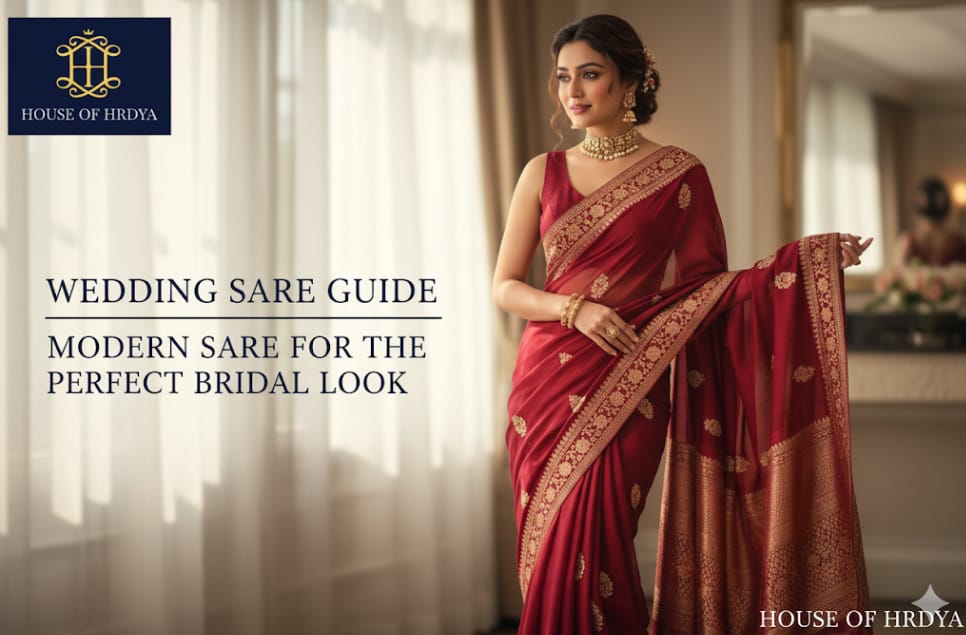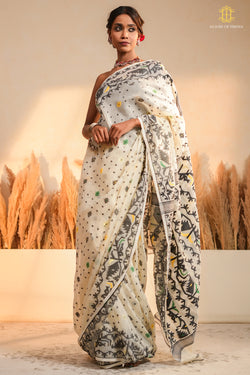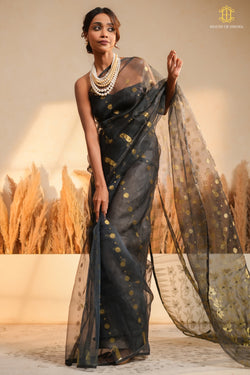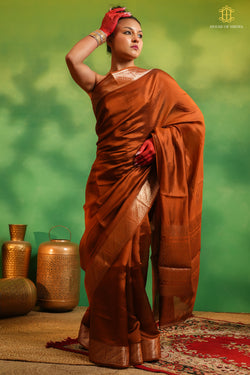A saree is more than just a garment—it’s a living canvas where tradition, craftsmanship, and personal style intertwine. In the era of evolving bridal fashion, the modern bride seeks a saree that honours heritage yet makes a statement. For brides who want to blend timeless elegance with contemporary flair, choosing the right saree is an art in itself. Whether it’s a destination wedding, a grand temple ceremony, or an intimate reception, the right modern saree can define your bridal identity.
When shopping for your bridal saree, you want not only beauty but reliability, authenticity, and exclusivity. That’s why many brides today turn to the best website to buy sarees online, carefully selecting from curated collections that promise quality, design, and elegance. Among these, House of Hrdya aims to be a go-to portal offering the best saree collection online, rooted in tradition yet reimagined for the modern bride.
In this comprehensive guide, we'll walk you through how to pick the best latest saree collection, what to look for in fabrics, weaves, embellishments, draping styles, and styling tips. We'll also highlight how you can find the Indian best saree collection and make your bridal journey smooth and beautiful. Let’s begin crafting that perfect bridal silhouette, one drape at a time. For inspiration and high-quality sarees perfect for experimenting with these styles, visit House of Hrdya, the best website to buy sarees online.

Choosing the Right Fabric & Weave
Selecting the right fabric and weave is the foundation of a bridal saree’s comfort, drape, and durability. Here are key factors to consider:
1. Fabric considerations
- Silk variants – Banarasi silk, Kanjeevaram silk, Mysore silk each offer different weights, lustre, and fall. A bride might prefer slightly lighter silks (e.g. organza silk, tissue silk) for ease of movement.
- Blended fabrics & modern weaves – Blends of silk with chiffon, georgette, or organza can reduce weight while retaining elegance.
- Comfort & climate – For hot or humid venues, breathable fabrics like silk-cotton blends or light silk will keep you more comfortable.
2. Weave types & structure
- Zari, brocade, and jacquard – These lend richness and depth. Heavy zari brocades work for grand venues but may be too heavy for all-day wear.
- Minimalist weave styles – Subtle jacquards, tonal weaves, or texture-based weaves (Matka, tissue linen) give modern aesthetic without extreme heaviness.
- Structure & body – Fabric with body holds pleats and drapes better; soft fabrics lend a fluid silhouette. Striking a balance is essential.
3. Durability & handling
- Thread quality & finishing – A high-quality bridal saree must endure fittings, steaming, pinning, and possibly multiple wears (pre-ceremony, shoot, reception).
- Lining & reinforcement – Some sarees come with inner lining or borders reinforced to reduce stress on fabric.
- Care & preservation – Real silk weaves must be dried carefully and stored properly (wrapped in muslin) to stay beautiful beyond the wedding day.
When you search for the best designer saree collection, keep these fabric and weave considerations in mind. A saree that balances aesthetic drama with wearable comfort and structural integrity will become a treasured heirloom, not just a wedding day showpiece. You’ll find endless blouse pairing options and customization possibilities in the best saree collection online available at House of Hrdya.
Modern Bridal Styles & Silhouette Trends
The modern bride is no longer confined to the classic red silk saree; she experiments with silhouettes, cuts, and fusion touches. Here are emerging trends you should know.
A. Contemporary styles
- Cape-style sarees / saree gowns – These merge the saree’s drape with the ease of gowns or capes. The pallu or dupatta-like element is attached as a cape.
- Pre-stitched & ready-to-drape – Pre-pleated and stitched sarees help eliminate piping and adjusting during the ceremony.
- Pant-style sarees / dhoti sarees – Here, the lower portion resembles dhoti pants, offering comfort and ease of movement while keeping the saree essence.
B. Colour & palette experimentation
- Pastels and muted tones – Soft blush, mushroom, sage green, lavender are trending as alternatives to bold reds and burgundies.
- Metallics & tonal contrast – Combining gold, champagne, rose gold, or silver woven threads with a base color adds dimension.
- Dual-tone & ombré effects – Sarees that gradate from one hue to another, or have contrasting panels, create visual interest.
C. Embellishment & detailing
- Minimal vs maximal – Some brides prefer heavy Zardozi, mirror work, while others lean toward subtle sequin/textured embroidery.
- Motif play – Using modern motifs (florals, geometrical, abstract) rather than traditional paisleys or motifs gives a fresh twist.
- Edge detailing – Scalloped borders, laser-cut edges, and modern laces replace classic zari edges.
The modern silhouette is about storytelling — your saree should mirror your personality, comfort level, and the pulse of contemporary bridal fashion. When browsing the best latest saree collection, pick pieces that speak to both your traditional sensibilities and your contemporary vision.

Styling, Draping & Accessories
A saree’s impact lies not just in its fabric and design but also in how you choose to style, drape, and accessorize it. The right styling decisions can elevate even the simplest saree into a show-stopping bridal ensemble. Draping techniques, in particular, have evolved far beyond the traditional methods, allowing modern brides to express their personality and creativity. The classic Nivi drape remains timeless, but adding a contemporary twist—such as adjusting pleat placements to the side, creating hidden pleats, or draping it slightly higher—can transform the look instantly. The butterfly or seedha pallu style, where the pallu is fanned out dramatically across the shoulder, is another popular choice, especially for photographs and grand entrances. Many brides today also embrace belted drapes, using ornate metal or embroidered belts to cinch the waist and give the saree a structured, couture-like silhouette.
Equally important is the blouse design, which can completely redefine the mood of the saree. Statement backs with intricate cuts or sheer illusions add a bold and dramatic flair, while cape sleeves, bell sleeves, or detachable sleeves bring versatility and creativity to the look. For brides who prefer a more contemporary appeal, crop-top or bustier-style blouses create a structured, modern vibe that complements both traditional and fusion sarees. Pairing your saree with a contrasting blouse—be it velvet, a bold color, or intricate embroidery—can also add depth and highlight the overall ensemble beautifully. Explore the Indian best saree collection and modern styling ideas at House of Hrdya to create a bridal look that’s timeless, elegant, and uniquely yours.
Accessories complete the bridal story. Choose jewellery that harmonizes with your saree’s detailing—elaborate Kundan, Polka, or temple jewellery for regal grandeur, or minimal modern pieces for understated elegance. Hair accessories such as fresh flowers, maang tikkas, or statement head chains enhance the bridal aura, while footwear and clutches in complementary tones pull the look together. When exploring the Indian best saree collection or browsing through the best saree collection online shopping, focus on pieces that offer styling flexibility, enabling you to experiment with drapes, blouses, and accessories to create a look that is truly your own.
Budgeting, Customization & Sourcing Tips
Buying a bridal saree involves more than just picking a design — you also want intelligent budgeting, tailored customization, and reliable sourcing. Below are key tips.
1. Setting a realistic bridal saree budget
- Breakdown costs – Consider fabric, weaving, embroidery/embellishment, dyeing, lining, petticoat, blouse, and trimming.
- Allocate contingency – Always keep 10–15% extra for last-minute embroidery, alterations, or repairs.
- Balance drama vs wisdom – A very heavy saree may look grand in photos but become uncomfortable mid-ceremony. Choose smartly according to your wedding schedule.
2. Customization & made-to-order
- Tailoring & alterations – Confirm that the seller or designer offers adjustments in pleats, length, border, and fall.
- Personal motifs or initials – Many brides commission custom motifs (monogram, family symbols) to weave or embroider into borders or pallu.
- Mix-and-match elements – Some modern bridal collections allow you to choose blouse style, border style, or fabric contrasts as per your preference.
3. Sourcing from trusted platforms
- Check reputation & reviews – Platforms offering best website to buy sarees online often show customer images, reviews, and ratings to back authenticity.
- Verify craftsmanship & return policy – A genuine seller will offer zoomed images, fabric descriptions, and reasonable return or exchange policies.
- Watch delivery timelines & tracking – Bridal sarees often require last-minute adjustments, so timely shipping is crucial. Choose sellers who commit to timely delivery.
When evaluating the best designer saree collection or best saree collection online, check how flexible the seller is with customization and how trustworthy their logistics system is. This will reduce stress as your big day approaches.
Post-Wedding Care & Preservation
Your bridal saree is more than just a piece of clothing; it is a symbol of love, heritage, and cherished memories. Treating it with proper care ensures that it remains as stunning as the day you wore it, ready to be treasured and even passed down to future generations. The first and most crucial step after your wedding is professional cleaning. Always choose a dry-cleaning specialist who is experienced with delicate weaves such as Banarasi, zari, or brocade, as improper cleaning methods can damage the intricate fabric and embellishments. Once cleaned, allow the saree to breathe by airing it in a shaded, ventilated space before storing it. This helps eliminate any residual moisture that could lead to mildew or fabric weakening.
When it comes to storage, the right approach makes all the difference. Avoid using plastic covers, as they trap moisture and can deteriorate the fabric over time. Instead, wrap the saree gently in a soft muslin or cotton cloth, which allows it to breathe while protecting it from dust and light. Every three to six months, take the saree out, refold it along different lines to prevent permanent creases, and air it again in the shade. Placing silica gel packets or neem sachets nearby can help control humidity and deter insects, but ensure they don’t come into direct contact with the fabric.
Even after the wedding, occasional usage and proper maintenance can prolong your saree’s life. Limit its wear to special occasions to prevent unnecessary wear and tear, and address any minor snags or loose embellishments promptly with professional help. If you wish to display your saree, opt for protective cases with UV-filter glass and avoid direct sunlight. With these thoughtful steps, your saree from the best saree collection online will remain timeless, preserving the story of your special day for years to come.




